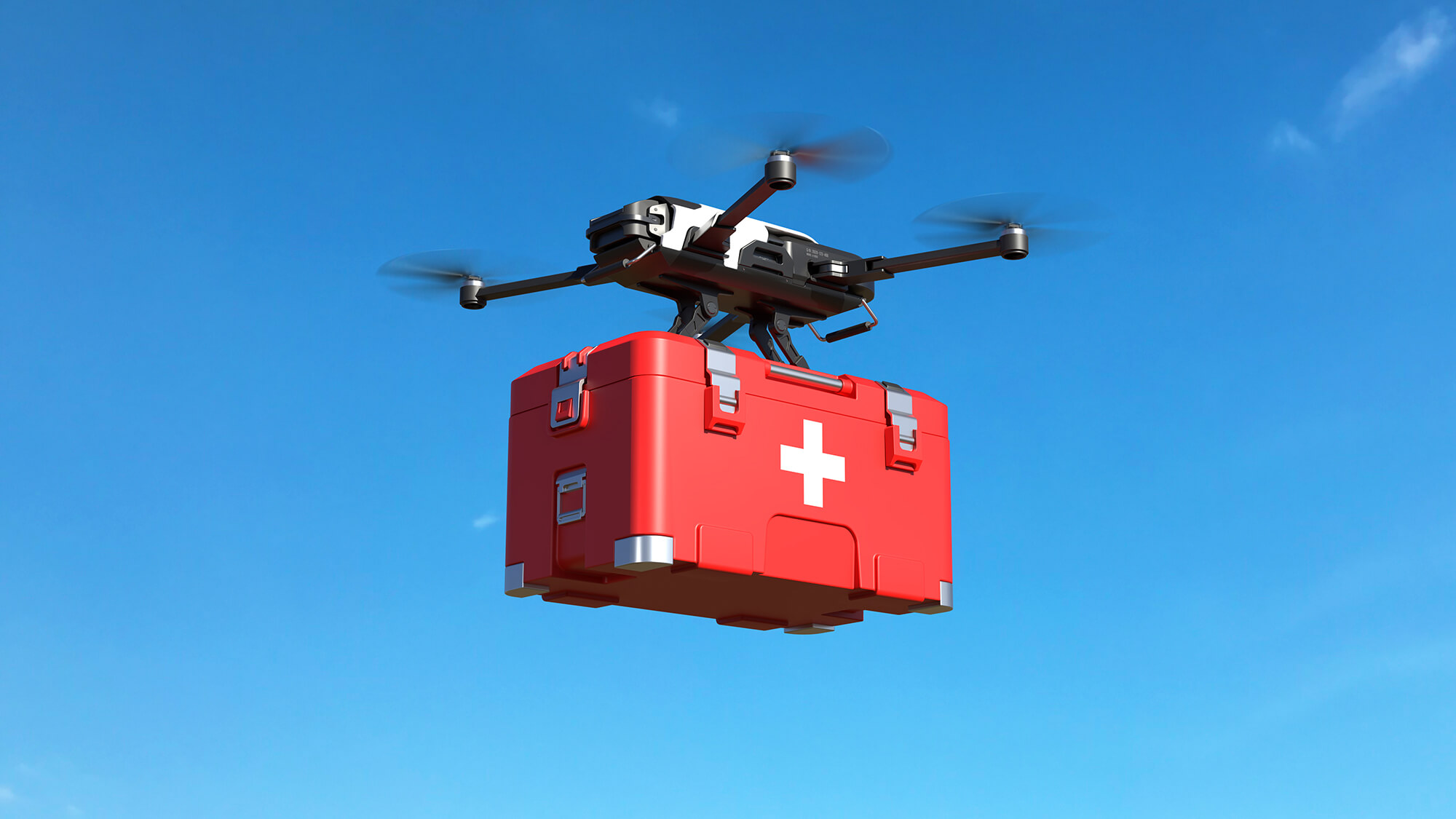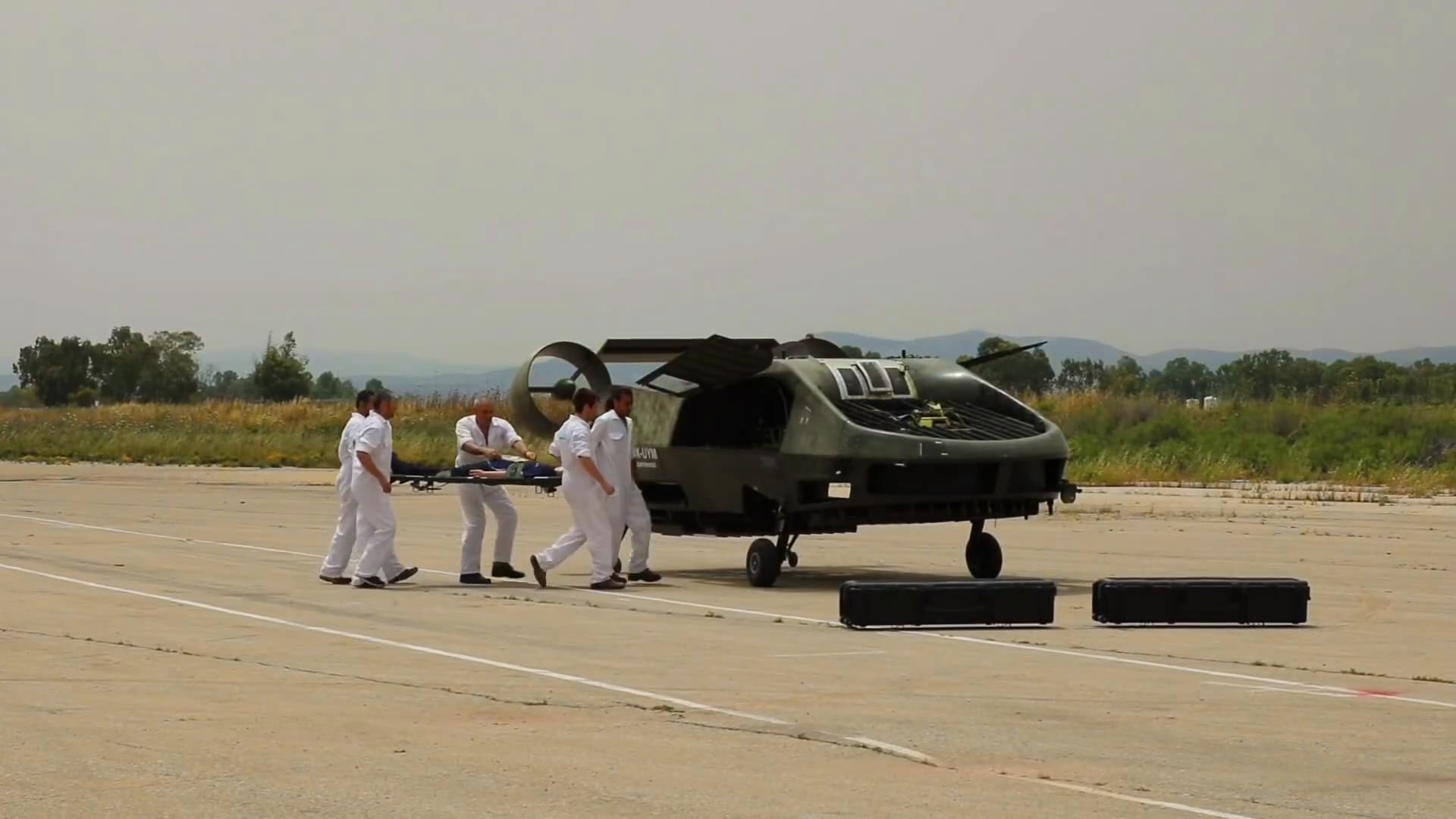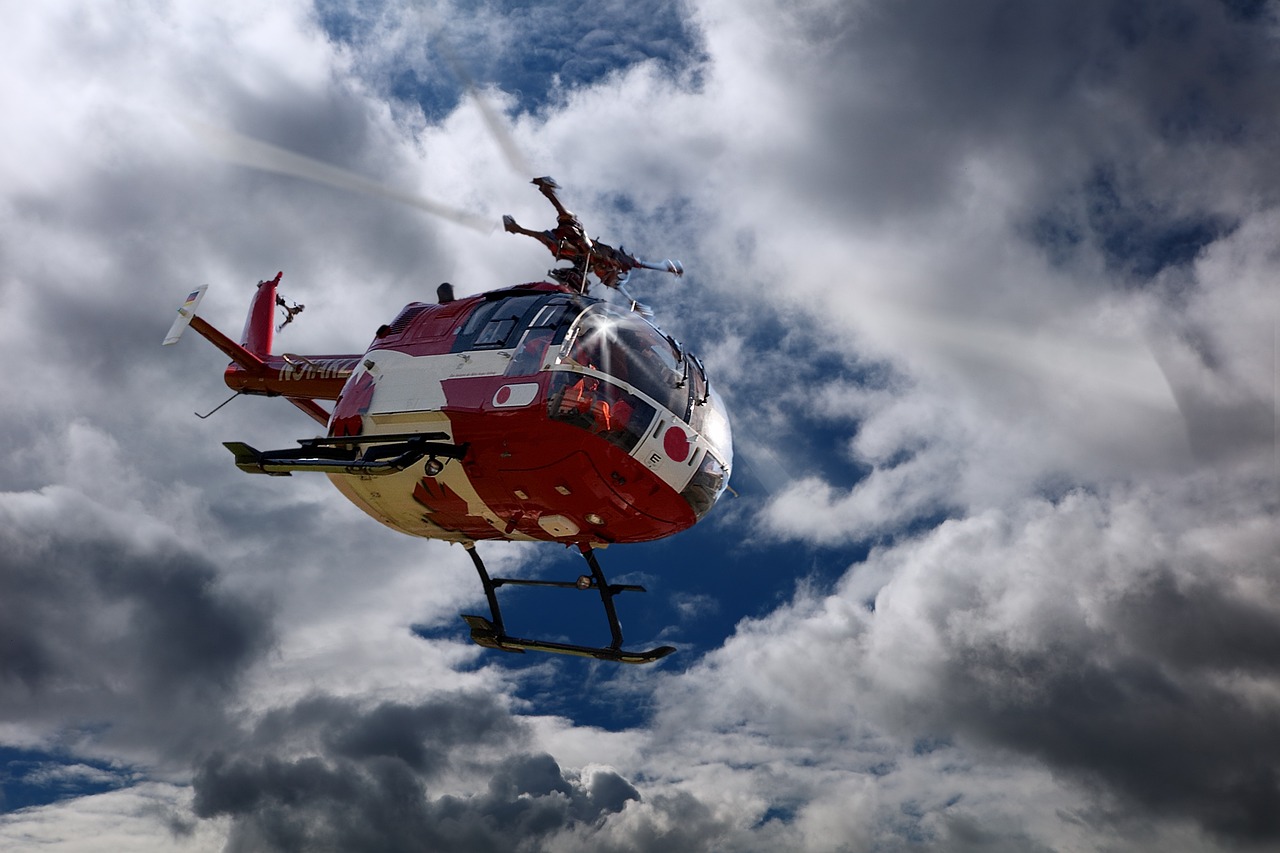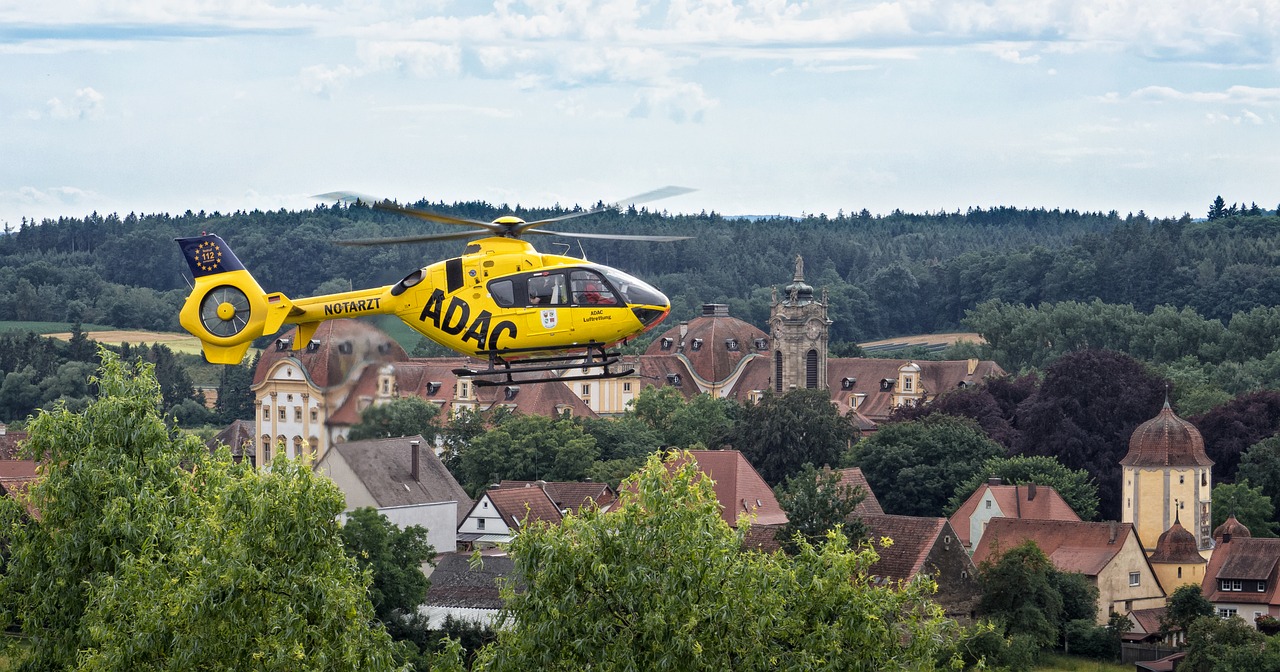In recent years, there has been a significant advancement in the utilization of drones in the field of air ambulance services. These unmanned aerial vehicles are revolutionizing the way emergency medical services are provided, especially in remote or hard-to-reach areas. Drones offer unique advantages such as swift response times, accessibility in challenging terrains, and the ability to transport medical supplies and equipment. This article will explore the growing role of drones in air ambulance services, shedding light on how they are enhancing emergency healthcare and potentially saving lives. So, let’s dive into this exciting development and explore the incredible potential of drones in the world of air ambulance services!

Introduction
Air ambulance services are a crucial part of emergency medical systems, providing rapid transportation and critical care to patients in need. These services are typically performed using helicopters or fixed-wing aircraft, but recent technological advancements have introduced an exciting new frontier in the field of emergency medical transportation – drones. Drones, also known as unmanned aerial vehicles (UAVs), have the potential to revolutionize air ambulance services by offering enhanced speed, improved accessibility to remote areas, and cost-effectiveness. In this article, we will explore the benefits of drones in air ambulance services, the technological advances in drone technology, use cases for drone integration, regulatory challenges, collaboration between drone manufacturers and air ambulance service providers, integration of drones in emergency medical systems, case studies of successful drone deployment, public perception and acceptance of drones, and the future of drones in air ambulance services.
Benefits of Drones in Air Ambulance Services
Enhanced speed and response time
One of the key advantages of using drones in air ambulance services is their enhanced speed and response time. Unlike traditional air ambulance vehicles, drones can bypass traffic and access areas that are difficult to reach by road or regular aircraft. With their ability to fly directly to the scene of the emergency, drones can significantly reduce the time it takes for medical personnel to reach the patient, ultimately improving the chances of survival for individuals in critical condition.
Improved accessibility to remote areas
Drones also offer improved accessibility to remote and hard-to-reach areas, such as mountainous terrains, disaster-stricken areas, or rural communities. In situations where time is of the essence, drones can swiftly transport medical personnel and essential medical supplies to these remote locations, bridging the gap between immediate emergency medical response and the arrival of ground-based services.
Reduced risks for medical personnel
By employing drones in air ambulance services, the risks faced by medical personnel can be significantly reduced. Traditional methods of transportation, such as helicopters or fixed-wing aircraft, often require specialized landing zones or runways, exposing medical personnel to potential dangers during takeoffs and landings. Drones, on the other hand, can take off and land in compact spaces with precision, eliminating the need for large landing areas and minimizing the risks associated with ground operations.
Cost-effectiveness and efficiency
Another notable benefit of utilizing drones in air ambulance services is their cost-effectiveness and efficiency. Drones are generally less expensive to operate and maintain compared to traditional aircraft, making them an attractive option for air ambulance service providers. Additionally, drones can navigate through congested airspace more efficiently, reducing fuel consumption and operating costs. This cost-effectiveness translates to more affordable emergency medical services for patients and healthcare systems, ultimately improving accessibility to critical care.
Technological Advances in Drone Technology
High-quality camera and imaging capabilities
One of the significant technological advances in drone technology is the development of high-quality camera and imaging capabilities. Modern drones are equipped with advanced imaging systems, including infrared cameras and high-resolution sensors, which allow medical personnel to gather real-time information and assess the condition of patients remotely. This feature is particularly valuable in situations where ground-based access is limited or compromised.
Autonomous flight and navigation systems
Autonomous flight and navigation systems have revolutionized the capabilities of drones in air ambulance services. These sophisticated systems enable drones to operate without constant human intervention, autonomously avoiding obstacles, adjusting flight routes based on real-time data, and maintaining stable flight even in adverse weather conditions. The integration of artificial intelligence (AI) algorithms further enhances the drones’ ability to navigate complex environments and make informed decisions during emergency situations.
Battery life and flight range improvements
Battery life and flight range improvements have also been essential advancements in drone technology. In the early days of drone usage, limited battery life significantly restricted their operational capabilities. However, with advancements in battery technology, drones can now fly for extended periods, covering longer distances without the need for frequent recharging. This increased flight range enhances the drones’ ability to reach remote areas and provide emergency medical assistance swiftly.
Payload capacity and transport capabilities
Recent advancements have also focused on improving the payload capacity and transport capabilities of drones. Increasing payload capacity allows drones to carry essential medical supplies, such as medications, blood products, or even medical equipment, to the site of the emergency. This capability enables medical personnel to begin crucial interventions immediately upon arrival, potentially saving precious time and increasing the chances of a positive patient outcome.

Use Cases for Drone Integration in Air Ambulance Services
Remote medical supply delivery
One of the most promising use cases for drones in air ambulance services is remote medical supply delivery. Drones can transport vital medical supplies, such as medications, vaccines, blood products, or defibrillators, to remote areas where access is limited or non-existent. This capability is especially crucial in disaster zones or during public health emergencies, where the rapid delivery of medical supplies can make a significant difference in saving lives and mitigating further risks.
Aerial search and rescue operations
Drones integrated into air ambulance services can also play a vital role in aerial search and rescue operations. Equipped with advanced imaging systems, drones can efficiently search large areas, identify survivors or individuals in distress, and relay their precise locations to ground-based search and rescue teams. This integration improves the overall efficiency of search and rescue efforts, expediting the identification and retrieval of individuals who require immediate medical attention.
Rapid organ transportation
Organ transplantation relies on the timely transportation of organs from donor to recipient. Drones present an innovative solution for the rapid transportation of organs over short to medium distances. By leveraging their speed and agility, drones can transport organs in specialized compartments, ensuring stable transportation conditions and minimizing the risk of damage or delays. This use case has the potential to revolutionize organ transplantation by reducing waiting times, optimizing organ allocation, and ultimately saving more lives.
Monitoring and surveillance during emergencies
In emergency situations, drones can be deployed to provide real-time monitoring and surveillance capabilities. By maintaining an aerial perspective, drones can survey large areas affected by natural disasters, identify potential hazards, and assist in coordinating emergency response efforts. Additionally, drones equipped with thermal imaging cameras can aid in locating individuals in need of medical assistance, even in low-visibility conditions. This critical information can help emergency medical teams prioritize their interventions and allocate resources effectively.
Regulatory Challenges and Considerations
Airspace regulations and integration with existing aviation systems
The integration of drones in air ambulance services poses significant regulatory challenges that must be addressed to ensure safe and effective operations. Airspace regulations need to be updated to accommodate the growing presence of drones and establish clear guidelines for their usage in emergency medical services. Additionally, the seamless integration of drones with existing aviation systems, such as air traffic control and radar systems, is vital to prevent potential conflicts and ensure the safety of both manned and unmanned aircraft.
Safety and reliability standards for medical payload transportation
Transporting medical payloads, such as medications or organs, requires adherence to stringent safety and reliability standards. Any disruption during transportation can have life-threatening consequences for patients. As such, comprehensive safety protocols and standards must be established to regulate the transportation of medical payloads via drones. Adequate safeguards, such as redundant systems, temperature control mechanisms, and fail-safe procedures, should be in place to ensure the integrity of medical supplies during transit.
Privacy concerns and data management
The use of drones in air ambulance services raises privacy concerns due to their ability to capture and record visual and sensor data. To address these concerns, strict guidelines on data privacy and management must be implemented. This includes ensuring secure data storage, appropriate anonymization of sensitive information, and explicit consent from individuals who may be captured by drone cameras during emergency response operations. Transparent communication regarding data collection and usage is vital to maintaining public trust and acceptance of drone integration.
Proposed solutions and ongoing initiatives
To tackle the regulatory challenges and considerations associated with the integration of drones in air ambulance services, various proposed solutions and ongoing initiatives are underway. Collaborative efforts involving government agencies, civil aviation authorities, drone manufacturers, and air ambulance service providers are focused on developing comprehensive regulatory frameworks, standardizing safety protocols, and addressing public concerns. These initiatives aim to create an environment that encourages innovation while ensuring the safe and responsible use of drones in emergency medical services.
Collaboration between Drone Manufacturers and Air Ambulance Service Providers
Partnerships and developments in the industry
Drone manufacturers are actively collaborating with air ambulance service providers to develop specialized drones that cater specifically to the needs of emergency medical transportation. These collaborations involve leveraging the expertise of both parties to design drones with enhanced capabilities, payload capacity, and flight range. By working together, manufacturers and service providers can create tailored solutions that optimize the delivery of emergency medical care.
Customization of drones for medical transportation
The customization of drones for medical transportation is a significant area of focus in the collaboration between drone manufacturers and air ambulance service providers. Customized drones may include features such as dedicated cargo compartments for medical supplies, integrated monitoring systems for real-time patient assessment, or even specialized sensor arrays for advanced diagnostics. This customization ensures that drones can effectively meet the unique requirements of air ambulance services and provide the necessary support to medical personnel.
Training and certification programs for drone operators
To ensure the safe and efficient operation of drones in air ambulance services, comprehensive training and certification programs for drone operators are essential. These programs encompass theoretical knowledge on aviation regulations, emergency response protocols, and operational skills specific to drone usage in emergency medical services. By equipping operators with the necessary training and certification, the risk associated with potential human error can be minimized, and the quality of emergency medical transportation can be significantly enhanced.
Insurance and liability considerations
As with any technology-driven industry, insurance and liability considerations play a crucial role in the collaboration between drone manufacturers and air ambulance service providers. Insurance providers must develop specialized policies that cover drone usage in emergency medical services, encompassing risks associated with operations, payload transportation, and potential accidents. Clear liability frameworks should also be established to determine responsibility in case of any unforeseen incidents to ensure adequate protection for all stakeholders involved.
Integration of Drones in Emergency Medical Systems
Coordination with ground-based emergency services
For seamless integration, coordination between drones and ground-based emergency services is essential. This coordination involves establishing effective communication channels, such as dedicated radio frequencies or data sharing platforms, to ensure real-time information exchange between drones and ground-based responders. Collaborative planning and joint training exercises between drone operators and ground-based emergency medical teams foster a mutual understanding of roles, capabilities, and the application of best practices during emergency response scenarios.
Establishing communication and control networks
To enable the integration of drones in emergency medical systems, the establishment of communication and control networks is paramount. These networks facilitate real-time monitoring, communication, and control of drones, allowing operators and medical personnel to track drone movements, assess patient conditions, and make informed decisions based on the available data. Robust networks, including reliable cellular connectivity or dedicated satellite communication systems, ensure uninterrupted communication and enable efficient management of drone operations.
Protocols for seamless integration and handover
Protocols must be established to ensure seamless integration and handover between drones and ground-based emergency medical services. These protocols outline the procedures for drone deployment, the sharing of information, and the transition of care between drone-based emergency medical personnel and ground-based responders. By incorporating clear protocols, potential gaps or delays in patient care can be minimized, ensuring a smooth transition during emergency medical situations.
Emergency response planning and coordination
Emergency response planning and coordination are crucial when integrating drones into emergency medical systems. Collaborative efforts involving stakeholders from various sectors, including government agencies, emergency medical services, drone manufacturers, and telecommunications providers, are vital for effective emergency response planning. These efforts encompass the development of standardized emergency response protocols, mutual aid agreements, and joint training exercises, all aimed at optimizing the use of drones in emergency medical situations.
Case Studies of Successful Drone Deployment in Air Ambulance Services
Examples of real-life situations where drones were utilized effectively
Numerous real-life case studies demonstrate the successful deployment of drones in air ambulance services. For instance, in rural communities with limited road infrastructure, drones have been used to transport medical supplies to patients during emergency situations, ensuring timely access to critical care. Drones have also been employed in disaster zones to survey impacted areas, identify survivors, and assist in the organization of rescue operations. These examples highlight the potential and effectiveness of drones in enhancing emergency medical services.
Positive outcomes and patient testimonies
Positive outcomes resulting from the integration of drones in air ambulance services have been reported in several instances. Patients who have benefited from the rapid response and medical care provided by drones have shared their testimonies, highlighting the life-saving impact of this technology. These testimonials serve as powerful evidence of the significant role drones can play in improving patient outcomes and saving lives, further emphasizing the importance of continued efforts to integrate drones into emergency medical systems.
Lessons learned and areas for improvement
As with any emerging technology, the deployment of drones in air ambulance services has been a learning experience. Lessons learned from initial deployments have highlighted the need for robust communication networks, standardized operating procedures, and ongoing training and certification for drone operators. Additionally, there is an ongoing need to address technological challenges, such as improving battery life, payload capacity, and the ability to operate in adverse weather conditions. Continuous improvement and refinement of drone technology and operational procedures are crucial for the successful and sustainable integration of drones in air ambulance services.
Future potential and scalability
The future potential of drones in air ambulance services is vast. As drone technology continues to advance, the capabilities of these unmanned aerial vehicles will expand, allowing for more sophisticated medical interventions and improved patient care. The scalability of drone integration is also promising, with the potential to deploy fleets of drones in response to mass casualty incidents or large-scale emergencies. Continued research, development, and collaboration will pave the way for the realization of this future potential, making drones an integral part of emergency medical systems worldwide.
Public Perception and Acceptance of Drones in Air Ambulance Services
Educating the public on the benefits and limitations of drone usage
Public perception and acceptance of drones in air ambulance services play a vital role in their successful integration. It is crucial to educate the public about the benefits and limitations of drone usage, dispelling any misconceptions or unnecessary fears. Educational campaigns highlighting the life-saving potential, improved response times, and cost-effectiveness of drones can foster a positive understanding and acceptance of their role in emergency medical services.
Addressing concerns and misconceptions
Addressing concerns and misconceptions surrounding drones in air ambulance services is essential for building trust and acceptance. Common concerns, such as privacy infringements or safety risks, must be addressed transparently, highlighting the rigorous regulatory frameworks, safety protocols, and privacy safeguards in place. Sharing success stories and case studies that demonstrate the responsible usage of drones may help alleviate concerns and foster a more positive perception among the public.
Community engagement and feedback
Engaging the community in discussions surrounding the integration of drones in air ambulance services is crucial for establishing a collaborative environment. Regular community forums, public consultations, and feedback channels provide opportunities for individuals to voice their concerns, ask questions, and contribute to the decision-making process. This community engagement fosters a sense of inclusivity, enabling the development of drone operations that are not only effective but also address the unique needs and concerns of the communities they serve.
Building trust and acceptance for drone integration
Building trust and acceptance for drone integration requires a multi-faceted approach. It involves open and transparent communication, proactive engagement with community stakeholders, and the establishment of clear and comprehensive guidelines for drone usage. Demonstrating the positive impact of drones in emergency medical services through public demonstrations, media coverage, and continuous education initiatives can significantly contribute to building trust and acceptance among the public.

Future of Drones in Air Ambulance Services
Continued technological advancements and innovation
The future of drones in air ambulance services holds immense potential for continued technological advancements and innovation. Ongoing research and development efforts will focus on improving drone capabilities, such as increased flight range, higher payload capacity, and enhanced imaging systems. Technological innovations, including the integration of AI and machine learning algorithms, are poised to further enhance the autonomy and decision-making capabilities of drones, making them more effective and efficient in emergency medical situations.
National and international regulations on drone usage
National and international regulations on drone usage will play a pivotal role in shaping the future of air ambulance services. Governments and civil aviation authorities must continue to update and refine their regulations to accommodate the growing presence of drones in emergency medical systems. Harmonization of these regulations at an international level will facilitate cross-border operations, promoting seamless emergency medical transportation and ensuring consistent safety standards.
Research and development for medical-specific drone designs
Research and development in the field of medical-specific drone designs will drive innovation and improve the functionality of drones in air ambulance services. The customization of drones to cater specifically to medical transportation needs, including the integration of specialized medical compartments or diagnostic capabilities, will further optimize their role in emergency medical systems. Collaborative efforts between medical professionals, engineers, and drone manufacturers will be instrumental in developing these medical-specific drone designs.
Collaborative efforts for widespread implementation
Collaborative efforts between various stakeholders, including government agencies, emergency medical services, drone manufacturers, and research institutions, will be essential for the widespread implementation of drones in air ambulance services. Partnerships and collaborations will drive innovation, bridge gaps in knowledge and expertise, and accelerate the adoption of drone technology in emergency medical systems. By working together, these stakeholders can overcome challenges, address regulatory complexities, and realize the full potential of drones in saving lives and improving patient outcomes.
In conclusion, drones are poised to play an increasingly significant role in air ambulance services. The benefits they offer, including enhanced speed and response time, improved accessibility to remote areas, reduced risks for medical personnel, and cost-effectiveness, make drones a valuable asset in emergency medical systems. Technological advancements in drone technology, such as high-quality imaging capabilities, autonomous flight systems, improved battery life, and increased payload capacity, further enhance their capabilities and potential. Use cases for drone integration in air ambulance services, such as remote medical supply delivery, aerial search and rescue operations, rapid organ transportation, and monitoring during emergencies, demonstrate the diverse applications of drones in emergency medical care. However, integrating drones into emergency medical systems requires addressing regulatory challenges, fostering collaboration between drone manufacturers and air ambulance service providers, establishing seamless communication and control networks, and building public trust and acceptance. Through ongoing research, collaboration, and public engagement, the future of drones in air ambulance services holds immense promise for transforming emergency medical care and saving lives.



